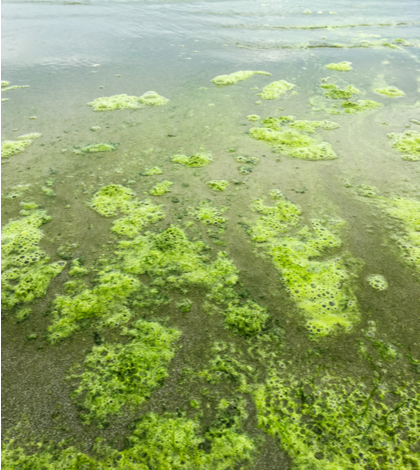‘Tis the season – for algal blooms, E. coli and warnings for waterborne illnesses.
As the summer season begins to warm temperatures throughout the state, the risks of waterborne illnesses become an anticipated part of the landscape. Californians – and those visiting the Golden State for summer vacations and recreation – can safely pursue water activities and sports if you remain vigilant and heed warnings from the various authorities.
The state’s Department of Water Resources (DWR) regularly tests the State Water Project (SWP) water for algal toxins, also known of as Harmful Algal Blooms (HABs) and/or blue-green algae. Multiple factors that can cause algae to grow, such as warm water temperature, calm conditions, and certain nutrients in the water. Blue-green algae (cyanobacteria) naturally occurs in lakes and can grow very rapidly to become an algal bloom.
Regardless of how or where it’s found DWR urges swimmers and boaters to take the necessary precautions and stay away from algae. Although some algae are harmless, certain types can produce toxins that can make people and animals sick. There is no way to tell if an algal bloom is toxic just by looking at it.
When testing for the toxins are positive, DWR signs are posted on site, at the reservoir and online. Once toxic algae are found, testing continues, and algae levels/warnings are not reduced until lab results show the water has been below the positive test level for two weeks.
The Central Valley Water Regional Water Quality Control Board (CVWRWQCB) has issued its warnings for E. coli. These bacteria found in the environment, foods, and intestines of people and animals. E. coli are a large and diverse group of bacteria and though most strains of E. coli are harmless, others can make you sick.
State Water Board staffers will be collecting weekly E. coli water samples in selected watersheds as a way to monitor the overall well-being of recreational waters. However, pinpointing the sources of E. coli is particularly challenging because it is found in pets, livestock, wildlife, and human waste. Recreational uses are assessed using bacteria water quality objectives designed to protect recreational users from the effects of pathogens in California’s waters. Waterbodies that do not meet the protective water quality objectives are placed on a list of impaired waters. You can view a map of the waters listed as impaired for recreation at https://mywaterquality.ca.gov/safe_to_swim/impaired_waters/index.html.
Healthy water habits are encouraged for everyone recreating in waterbodies including:
- Follow all posted advisories
- Stay away from algae and scum in the water and on shore
- Watch children and pets closely
- Do not let pets and other animals go into the water, drink the water, or eat scum and algal accumulations on the shore
- Do not drink river or lake water
- Do not cook or wash dishes with river or lake water
- Wash yourself and your family, including your pets, with clean water after swimming. Be sure to wash your hands before eating
- If you have concerns regarding your family’s health, contact your healthcare provider immediately
- If you catch fish, throw away guts and clean fillets with tap water or bottled water before cooking
- Avoid eating shellfish from affected areas
Additional resources on HABs can be found at:
- California Water Quality Monitoring Council (https://mywaterquality.ca.gov/habs/)
- California Department of Public Health (https://www.cdph.ca.gov/Programs/CCDPHP/DEODC/EHIB/EAS/Pages/HABs.aspx)
- State Water Resources Control Board (https://mywaterquality.ca.gov/habs/what/index.html)
- CA Office of Environmental Health Hazard Assessment (https://oehha.ca.gov/ecotoxicology/general-info/information-microcystins)
- US Environmental Protection Agency: CyanoHAB website (https://www.epa.gov/cyanohabs)
- Centers for Disease Control and Prevention (https://www.cdc.gov/habs/)
Additional information regarding E. coli is available at:
- State Water Boards Bacterial Objectives (https://www.waterboards.ca.gov/bacterialobjectives/)
- A listing of Impaired Waters (https://www.waterboards.ca.gov/water_issues/programs/water_quality_assessment/#impaired)
- A map of the current impaired waters (https://mywaterquality.ca.gov/safe_to_swim/impaired_waters/index.html)
 California Water News Daily Your Source For Water News in California
California Water News Daily Your Source For Water News in California


